An ode to medieval and modern
Celebrating the talent and contributions of Eyvind Earle, on his birthday
As a child, one of my favorite Disney films was Sleeping Beauty. I couldn’t articulate it at the time, but I was mesmerized by the color, geometry, and texture of the scenes. There was just something about it that separated the film from all the others that were in my almost-constant rotation, but it wasn’t until a couple decades later when I learned who was responsible for the film’s unforgettable style — Eyvind Earle.
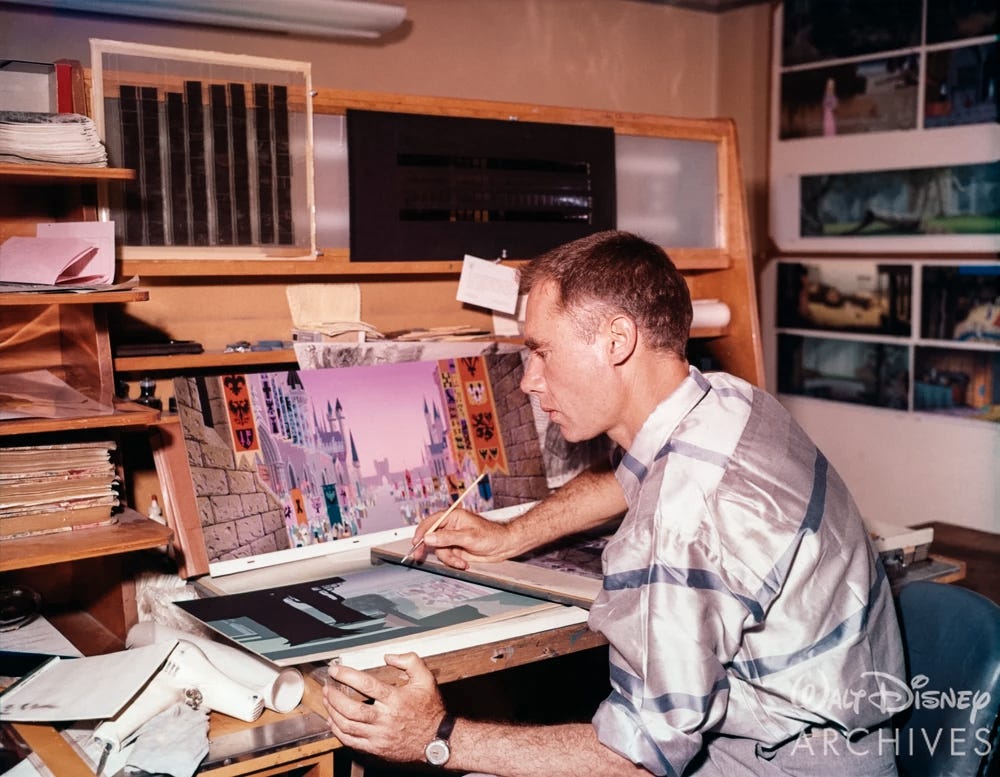
Inspired by the work of pre and early-Renaissance artists (i.e. Pieter Bruegel, Botticelli, Albrecht Dürer, and more), more recent masters (i.e. Van Gogh, Cézanne, Rockwell Kent, and Georgia O'Keefe), and animators at the inventive UPA animation studio, Earle defined his creative approach and signature style through the use of bold, opaque colors alongside simplistic and harmonious shapes and form that were elevated by the inclusion of smaller details.

By the time Earle had arrived at The Walt Disney Studios in 1951, he had already spent years building upon his skills and establishing himself as a fine artist. One might be able to attribute this early period of his career to a series of rejections he received almost two decades prior by none other than the same man who later hired him to work on backgrounds for animated films like Peter Pan, Toot, Whistle, Plunk, and Boom, and Lady and the Tramp — Walt Disney.
The bright-eyed, 18-year-old Earle first applied for a job at the old studio on Hyperion Avenue in 1934 but was rebuffed. He gave it another shot the following week but was rejected again. He continued reaching out to the studio for three years before he ultimately tabled his dream and pursued other avenues, like joining the military, attending art classes, painting portraits, and designing Christmas cards.
After those years spent refining his craft, Earle was hired by the studio to begin work on backgrounds that would be used in short works and films that would later define what we now know as the “Silver Era” of Disney animation.
“I remember the first day I came to work…up on the wall…were about 100 exquisite little paintings by Mary Blair… In my mind, I said to myself, ‘That’s the job I want at Disney.’” — Eyvind Earle
Although he worked on many projects for the studio, Earle’s legacy shines brightest through his spectacular oeuvre of stylistic choices — color palettes, texture, and attention to negative space — and paintings produced for the 1959 film Sleeping Beauty.
Ever the innovator, Walt envisioned a film that was visually different from the ones that preceded it. It needed a creative style that was consistent throughout the entire film, and he knew that assigning one artist — an unprecedented decision — to dictate and oversee the artistic production would achieve that objective. Walt recognized Earle’s talent and handed over the keys.
Due to Earle’s meticulous process and attention to detail, production on the film took far longer than most at the studio. In fact, it spanned most of the 1950s. Earle had complete creative control over the backgrounds, character designs, and color palettes, and is said to have touched at least every background used in the film. Whereas a standard background in a Disney production might’ve taken a couple days to complete, those created for Sleeping Beauty took up to 10 days under Earle’s direction.
Animator Floyd Norman said, “The work was demanding and the expectation was the highest of any animated film ever produced… Drawings that would ordinarily be considered insignificant in any other film would be given the highest attention. No detail was too small to be considered.”
The animators felt like fish out of water. They weren’t used to abiding by one single artist’s style, along with having so much emphasis placed on the backgrounds. In previous films, the artistic focus was always on the animations and they felt that the backgrounds took away from their work. So one day, a handful of animators marched up to Walt’s office and shared their frustrations with him.
Despite their efforts, Walt wouldn’t budge. He was committed to producing a film that stood out stylistically amongst its predecessors and encouraged the animators to compromise with Earle.

Eventually, the animators began to recognize the unique beauty and cohesive design of what was slowly becoming Sleeping Beauty. Curious about his creative process, they would often poke their heads in Earle’s office to see what he was up to.1 “I think everybody that worked at the Disney Studio came to see what I was painting,” Earle remembered. Sleeping Beauty was his last but arguably the most iconic project of his time at the studio, and perhaps of this era of Disney animation as well.
When I watch Aurora and Prince Philip waltzing through the forest or Maleficent using her fluorescent fire, I hope to always think of Earle and his artistic contributions to the film that would forever cement its place in my heart and memory. That’s magic, noted.
Tomorrow, April 26th, would be Earle’s 109th birthday and instead of writing more about his life, I thought it’d be more impactful to hear about it from the man himself. Below are three short videos that are narrated by Earle and comprise an autobiographical account of his long and illustrious life that was released shortly before his death in July 2000.
Eyvind’s early and adolescent years
Studio life, and “the end of being poor”
Eyvind’s creative inspirations and philosophies
“Art is a search for truth. Art is another word for life, and life is infinite. Beyond definition. Beyond understanding, even. Nothing said can contain but a drop of it. Art encompasses all aspects of existence. Life and truth and consciousness and color and sound and feeling; all of the same thing… Art is an attempt to capture life. To crystalize and make permanent that which is forever fleeting and changing.” — Eyvind Earle
How Eyvind is remembered
For further viewing
The official website of Eyvind Earle, which features a biography along with photos and videos of his life and creations
A catalog of Eyvind’s work outside of Disney
Awakening Beauty: The Art of Eyvind Earle by Ioan Szasz
Where to find it: This book seems to be out of print, but there’s some copies available if you happen to have a small fortune. Otherwise, here’s a great flip-through of the book.
Horizon Bound on a Bicycle: The Autobiography of Eyvind Earle by Eyvind Earle
Where to find it: Gallery21
Well, that’s all I’ve got for today. I hope this post was an insightful peek into the process of developing Sleeping Beauty, as well as a good look at the creative genius who helped bring the film to life.
If you enjoyed today’s post, be sure to smash that lil’ heart icon below! It helps increase this post’s visibility on Substack and brings more folks closer to the magic. As always, thank you so much for reading. I appreciate you being here.
See ya real soon,
👋🏻 Lookin’ for more magic? Come say “hi” on Instagram!
☕ Help fuel those early mornings and late nights by buying me a coffee
💬 Found something in this post that resonated with you? Highlight and share it as a note to your Substack feed!
💌 Spread the magic by sending this post to a fellow Disney nerd
🗣️ Got a Substack of your own? Recommend Magic, Noted to your readers!
Solomon, Charles. “How Eyvind Earle’s Stunning Art Made Sleeping Beauty a ‘Moving Illustration.’” D23. 19 March, 2019, https://d23.com/sleeping-beauty-stunning-art/.






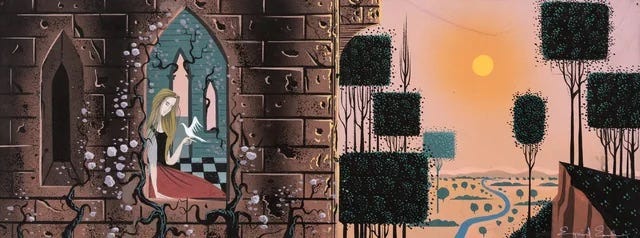
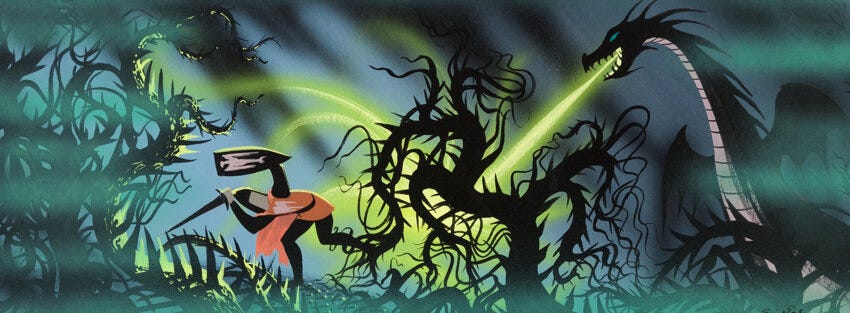

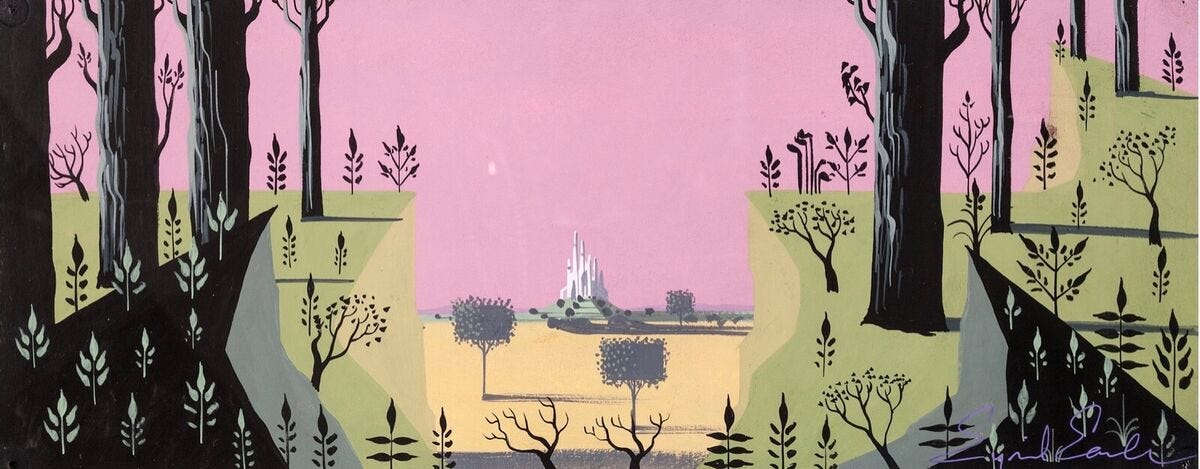
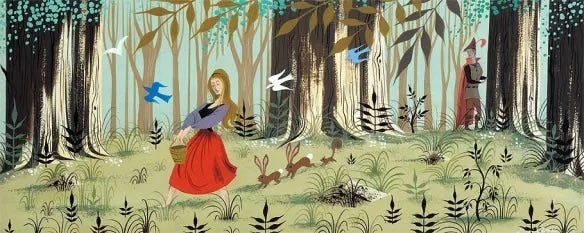



The artwork in this film in particular is so stunning. I love the side-by-side comparison you included. The opening sequence/credits have always stuck with me-- the gorgeous gilded book and calligraphy as the story comes to life right off the pages.